|
Biographical Log of Michael Furstner - Page 137
08 | 09 ||
2010 :
Jan |
Feb |
Mar |
Apr |
May |
Jun |
Jul |
Aug |
Sep |
Oct |
Nov |
Dec || Page :
Previous |
Next
The Martinshof Story -
A Philosophy of Happiness -
Life Awareness -
Maps & other Text series
Most Recent -
Next -
Previous -
Page 1 -
Photos -
Index -
Topics -
MP3s -
Jazclass Links
Thursday & Friday, January 21 & 22 2010
(diary)
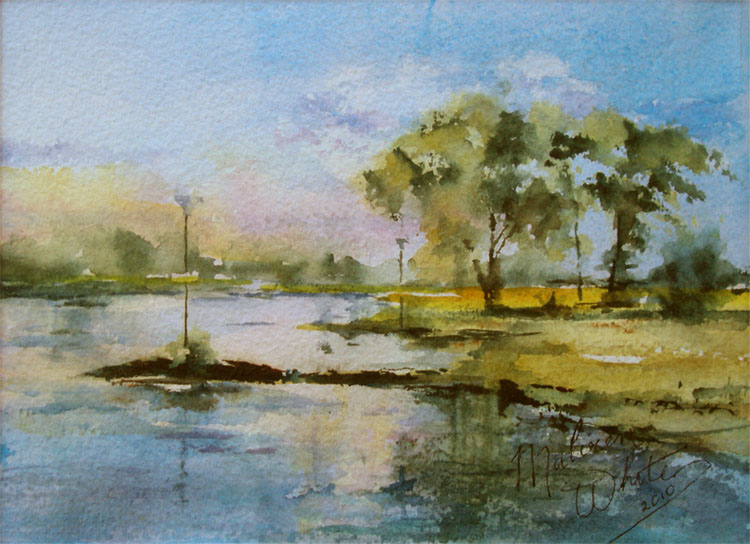 I met Malveen
White for lunch at the Mooloolaba Surf Club yesterday. We had not seen each other
for about 8 years and it was nice to catch up again. We may repeat the experience
and see each other perhaps again from time to time.
I met Malveen
White for lunch at the Mooloolaba Surf Club yesterday. We had not seen each other
for about 8 years and it was nice to catch up again. We may repeat the experience
and see each other perhaps again from time to time.
Malveen and I first met
in the mid 1990s and had a brief relationship, living together in my house in Nambour. But as we both are
very strong introvert types we each needed our own space, so we parted
after a year.
We tried again some years later but failed to
breach the gap between our so very different preferred lifestyles : me
always restless never able to remain long in one place, she happy to
remain in one location and be part of and contribute to the small community of Montville (located on the
mountain range overlooking the Sunshine Coast). Nevertheless the strong affinity
we felt towards each other has remained throughout all these years and about six
months ago we started communicating again by email.
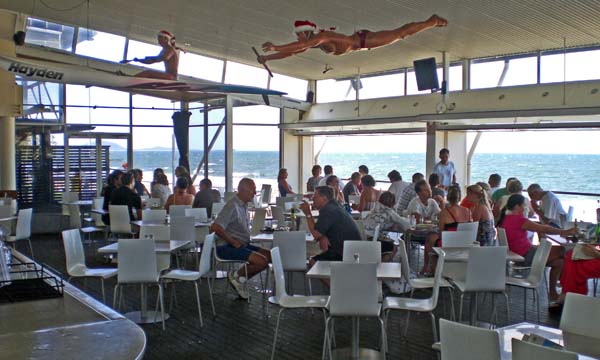 Yesterday over lunch we talked about many different things, but of course her art
was one of the subjects of interest. Malveen is a very accomplished water colour
artist with her own style and very considerable technical ability in this
medium. I always try to nudge her towards a more impressionistic - abstract
approach and Malveen has made some attempts in that direction. But she appears
to lean more towards learning new skills in her craft rather than jumping into
the unknown.
Yesterday over lunch we talked about many different things, but of course her art
was one of the subjects of interest. Malveen is a very accomplished water colour
artist with her own style and very considerable technical ability in this
medium. I always try to nudge her towards a more impressionistic - abstract
approach and Malveen has made some attempts in that direction. But she appears
to lean more towards learning new skills in her craft rather than jumping into
the unknown.
As I drive home, I suddenly realise that I have been
exactly the same in my life. Is this perhaps a common feature of strong
introverts ? We virtually live our life within our mind and are
therefore largely controlled by it. We tend not to venture out into a new
direction in life unless our mind is satisfied we are fully prepared for
it.
When I studied music in the 1980s my piano teacher would always maintain
that it was my mind that was holding me back, and of course he was right. In
improvisation too, I worked forever on scales, scale patterns, arpeggios, but for
a long time shied away from practicing real improvisation. Then suddenly
quality improvisation poured out of me as if coming from nowhere.
Even as
a young 7 year old boy this characteristic was present in me. We went to live
in Germany with my Grandparents in Wismar during the last year (1944-45) of World War 2.
Although I could understand everything what was said I did not utter a single
word in German for about three weeks. Then, suddenly, I started and to
everyone's amazement was absolutely fluent in the language.
Most Recent -
Next -
Previous -
Top -
Page 1 -
Photos -
Index -
Topics -
MP3s -
Jazclass Links
Saturday & Sunday, January 23 & 24 2010
(diary)
Walking on Mooloolaba beach after my swim on Sunday I, most unexpectedly,
suddenly encounter a very old friend. I have been looking out for him all summer
and thought he may perhaps have passed away. But no, he is still with us. It is
Stumpy the sea gull, cooling his lower leg stumps in an inch deep (2.5cm)
of surf at the water's edge.
I first spotted Stumpy here on the beach 12-15
years ago. I wrote a song for him at the time (Stumpy's Blues) and this is what I said about him then
:
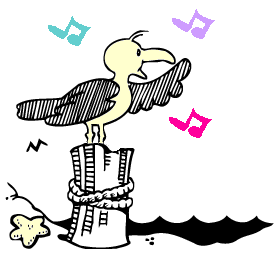 | Mooloolaba is a great beach, and very well
known in Australia. Amongst the many regulars are several Olympic Gold
medalists and other Sport Champions. It is also a favourite beach for
Surf Carnivals, Triathlons and Iron man competitions. There is
one famous
regular visitor to this beach who is quite different. His name is
Stumpy.
Stumpy is a well known
seagull on Mooloolaba Beach.
He lost both feet while skimming the
ocean waves in search of a meal, bitten off by a barracuda or shark faster
than him.
Stumpy is now very spoiled by all the regular beachees who
favour him with plenty of food, to the great disgust and jealousy of his
fellow seagulls. So you see, even the darkest cloud can have
a
silver lining ! |
Stumpy is still as well fed as ever and looks in very good shape. I quickly checked
online, could it really be him ? An yes, I believe so, sea gulls can reach the
very respectable age of 40-50 years. So I am quite sure it is him.
Most Recent -
Next -
Previous -
Top -
Page 1 -
Photos -
Index -
Topics -
MP3s -
Jazclass Links
Monday, January 25 2010
(diary, philosophy)
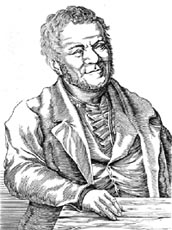 Philosophy of Happiness : 6 continues from January 11
Philosophy of Happiness : 6 continues from January 11
Occasional I come across a statement that just bowls me over. Here is one (which
I read in Alain de Botton's marvelous book "The
Architecture of Happiness") from the 19th Century French writer Marie-Henri Beyle
(1783-1842) better known by his pen name Stendhal
:
"Beauty is the promise of
Happiness."
And consequently :
"There are as many styles of Beauty
as there are visions of Happiness"
"With these statements" (writes Alain de Botton)
"Trendhal differentiates our love of beauty from an academic
preoccupation with aesthetics, and integrates it instead with the
qualities we need to prosper as human beings."
"If the search for happiness" (continues de Botton)
"is the underlying quest of our lives, it seems only
natural that it should simultaneously be the essential theme to which
beauty alludes to."
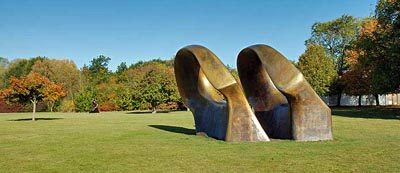 In other words : Beauty is as it were a material expression of happiness,
and when we are confronted with it, it brings out a feeling of happiness within
us.
In other words : Beauty is as it were a material expression of happiness,
and when we are confronted with it, it brings out a feeling of happiness within
us.
De Botton in his book only refers to the beauty of architecture and
design. But beauty of course can be found in many things : all art (paintings,
sculptures, music, ballet) as well as in nature itself (a sunset,
flower, bird, scenery).
I personally consider beauty as yet another dimension of my 6th factor
for achieving happiness : the environment.
1. Health 2. Freedom
3. Sense of Purpose
4. Thought 5. Friendship
6. Environment
 These dimensions of one's preferred environment are : your choice of Continent or
Country, the region or community you select to live in, your home, the beauty you
seek out or surround yourself with.
These dimensions of one's preferred environment are : your choice of Continent or
Country, the region or community you select to live in, your home, the beauty you
seek out or surround yourself with.
I find going to an art exhibition, a
concert or a play, admiring a small ornament, piece of jewelry etc., or sitting on
a beach watching the sun set all conscious attempts to stimulate my happiness.
I wonder whether Stendhal, Alain de Botton, or anyone else for that matter,
ever has contemplated extending Tendhal's proposition, or rather turning it
around.
For if
"Beauty is the promise of
Happiness"
it follows quite naturally that :
"Happiness is the fulfillment of
Beauty."
I believe that this is very much the case. For when we achieve happiness we
become in effect "material expressions of beauty", where our "beauty" is
expressed in our mood, attitude, facial expression and body language.
Seen from this perspective the pursuit of happiness is by no means an act
of selfishness. For through achieving happiness for ourself we add to the beauty
in this world and contribute to (or become catalysts for) the happiness of
others.
The Norwegian biologist Bjørn Grinde, in his book Darwinian Happiness, takes the impotance of Happinss even a step further. Here is part of a synopsis of his book from the Wikipedia :
Bjørn Grinde argues that human emotions find their cause in evolution and offers ways by which we can use this for our advantage.
More specifically, mammals are equipped with a nerve system that enables them to distinguish not only between pleasant and unpleasant sensations, but positive and negative experiences in general.
While the biological term fitness refers to the capacity to create offspring, happiness (or quality of life) is, at least in a biological perspective, a question of the qualities of the experiences our nervous system offers us.
In order to improve these experiences there are two main principles to consider: -
To utilize the rewarding sensations the brain is designed to offer in a way that gives optimal long-term benefits; and, similarly, to avoid punishing sensations.
-
To avoid stress and maladaptive ways of living in order to have a healthy mind with optimal potential for positive experiences.
Humans may actually have been equipped with more powerful positive and negative sensations, compared to other mammals, due to our capacity for free will. That is, evolution might tend to add stronger incentives for behavior benefiting the genes in an individual with a powerful free will; as otherwise, the free will could easily result in maladaptive behavior.
|
I find this a very exiting idea, as it strongly suggest that the pursuit of Happiness (as well as all other quailties we consider as good, positive or beautiful) actually helps to steer the evolution of our human species as a whole onto a progressive, positive course.
Philosophy of Happiness continues on February 5
Comments -
Most Recent -
Next Page -
Previous -
Top -
Page 1 -
Photos -
Index -
Topics -
Jazclass Links
Copyright © 2010 Michael Furstner
|





